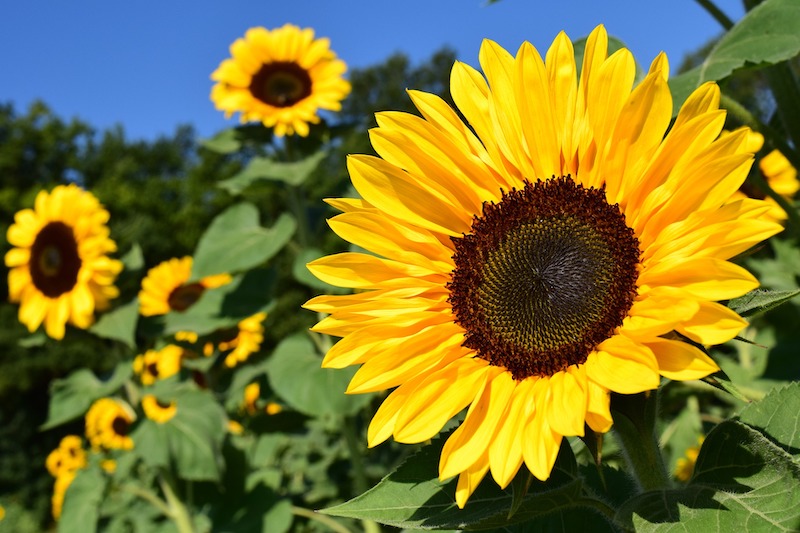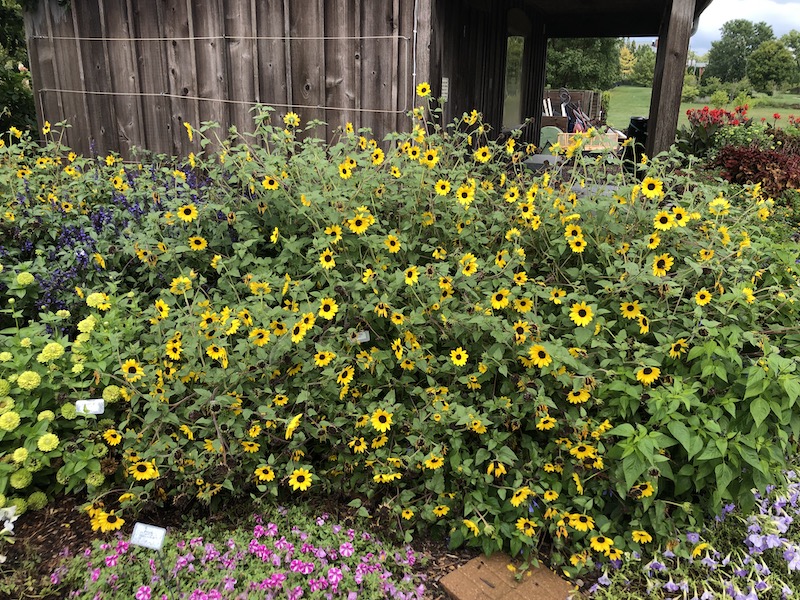Growing Sunflowers
Sunflowers (Helianthus) are an annual classic that can vary wildly in size and color. Their flower colors can range from bright yellow and orange to deep red. Blooms last all summer long and can continue well into fall. Sunflowers are known for their brown centers that can ripen with edible seeds in the case of Helianthus annuus, attracting songbirds and beneficial pollinators.
Sunflowers are hardy and highly adaptable–they’re heat tolerant and pest resistant. The largest sunflower cultivars are able to grow over 15 feet tall with a 10-inch diameter center, whereas the smallest varieties grow only about a foot tall. Sunflowers are heliotropic, meaning young sunflowers are able to follow the sun across the sky!

Planting Sunflowers
Select a bright, sunny location that receives at least 6 to 8 hours daily of direct sunlight. This location should also be sheltered from strong winds. Sunflowers aren’t too picky about soil types but prefer well-draining, slightly acidic to neutral soil. Sow sunflower seeds directly in the ground or a container after the last frost, usually between April and June. The roots can be fussy and transplantation is not recommended.
Plant at a depth of 1-2 inches deep and about a foot apart. Adequate space between plants will help reduce the chance of mildew. A sunflower sprout can appear in as little as one week, and matures in only 80 or 90 days.
Watering Sunflowers
Water thoroughly upon planting your sunflower seeds, and keep the soil somewhat moist until roots are established. Watering weekly will promote deep rooting. You can then wait until the top 1 to 2 inches of soil becomes dry before watering. After your sunflowers are established they are drought tolerant for brief periods of time. If you notice that there hasn’t been rain in a while, give your sunflowers a good drink of water. Mulching around your sunflowers will help retain soil moisture and keep out weeds.

Fertilizing Sunflowers
Initially sunflowers can be heavy feeders. Their soil should be nutrient-rich or supplemented with compost. Alternatively, you could use a slow release granular fertilizer. After the sunflower plants are established and blooming you’ll want to hold off on fertilizer. Bimonthly apply fertilizer at half strength. The food should be applied about one foot away from the plants to avoid fertilizer burn. Over-feeding sunflowers can lead to tall, leggy plants with fewer blooms.
Pruning Sunflowers
If you initially planted your sunflower seeds in clusters, the sprouts should be thinned out. Sunflowers are easy and typically do not need any pruning. However, most varieties will expire or go dormant in the winter months and can be cut back to the ground. Throughout the growing season sunflowers may be trimmed to control growth. You can remove spent sunflower blooms as needed to maintain a tidy appearance. Oftentimes, two blooms will replace a deadheaded bloom!
Caring For Sunflowers in Pots
Some sunflowers are better suited for containers than others. Select a cultivar compact enough for containers such as the Helianthus annuus ‘Teddy Bear’ variety, which grows to only 2 to 3 feet tall. Select a pot that can easily accommodate the root ball of your sunflowers and fill it with a potting mix. The potting blend should be well draining and contain plenty of organic matter. Seeds can be sown directly into the pot or container. Thin out the sunflower stalks as necessary to prevent overcrowding.

Winter Care For Sunflowers
When growing sunflowers in the ground, the foliage should be cut down after they have expired for the season. Wait until the stalks and foliage of the sunflowers are brown and crispy before you cut them back. If you have your sunflowers in containers, you’ll need to move them indoors or to a warm location for winter.
Some sunflower cultivars are perennial and will return the next growing season for several years. Several are also cold hardy, like the Helioanthus giganteus or ‘Giant Sunflower’, which is hardy to zone 3. Another great cold hardy perennial version is the ‘Western Sunflower’ (Helioanthus occidentalis).
 |
Author Chris Link - Published 3-6-2023 |
